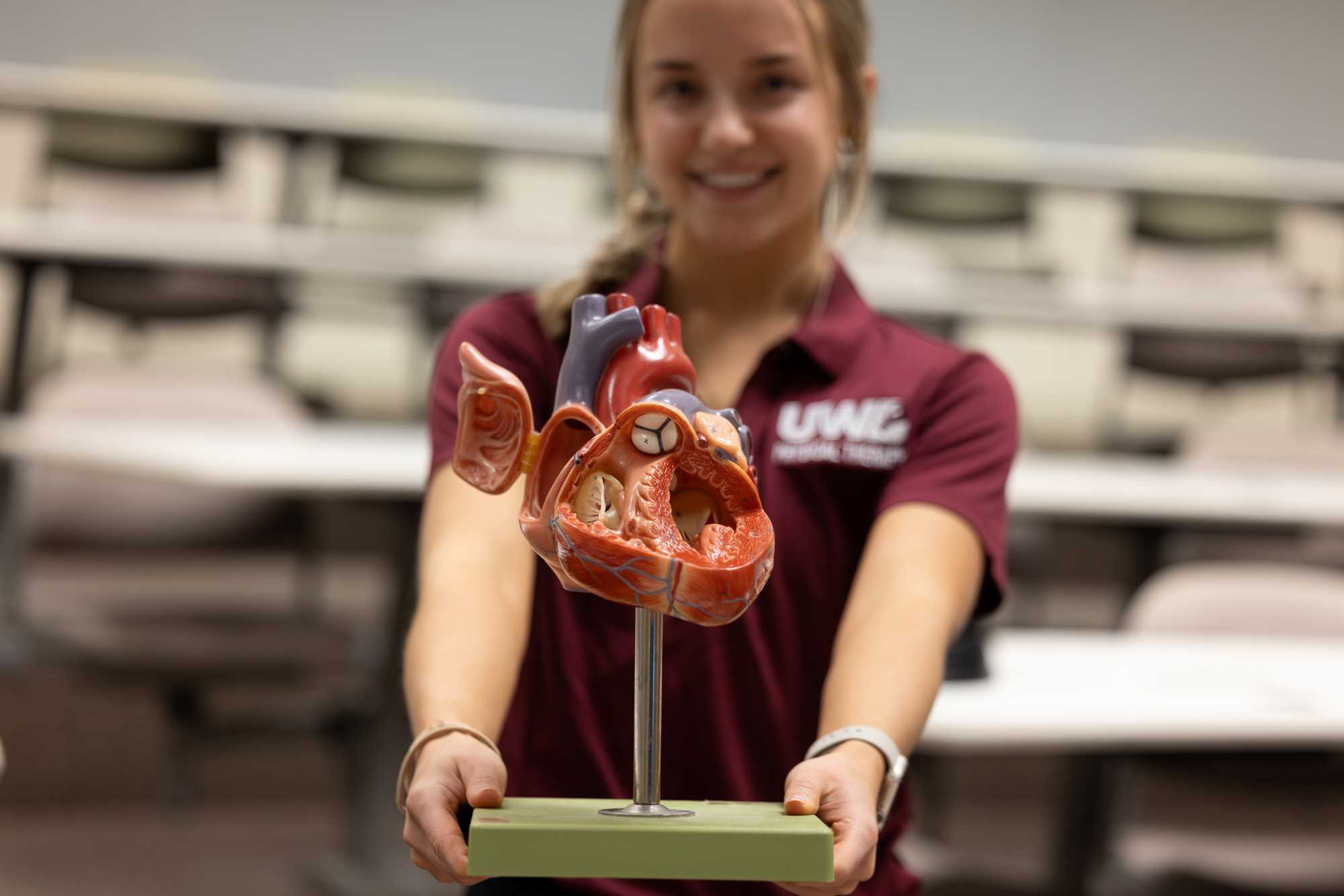Pre-Medicine program
Become a physician
Physicians diagnose and care for people of all ages who are ill or have been injured, and also work to prevent health problems before they occur. If you are interested in the intricacies of the human body’s systems, leadership, and helping others, medicine may be right for you. Physicians fill a variety of roles in a variety of settings, whether they choose DO (osteopathic) or MD (allopathic) training.
The Pre-Medicine track also prepares students who plan to apply to Podiatry Schools or Anesthesiologist Assistant Programs. The prerequisites are similar enough for the coursework below to be a good starting point.
Pre-Medicine is NOT a major at UW-La Crosse. It declares your intent to apply to medical schools. Pre-med track students may apply to both MD and DO medical schools. Like MDs, DOs practice in all areas of medicine with an emphasis on the health of the whole person.
Students will need to select a major to complete a degree at UWL.
Pre-med advising info and FAQs
FAQs:
- Who is my pre-med advisor? Check your WINGS Student Center. The Pre-Health Center can help with additional questions.
- How do I update my major and/or add pre-med to my record? You can use your college's change of major form.
- What major should I pick? Whichever major will keep your interest and challenge you at UWL. Connect with the Academic Advising Center & Career Services.
- What is this non-credit Canvas course? Pre-med students are able to self-enroll in the "Pre-Health Prep" course, which includes many pre-med resources.
- What are other good pre-med resources? Read advice for aspiring physicians on The Association of American Medical Colleges website. Check out these podcasts: Case Western's "All Access: Med School Admissions" and Med School HQ.
- How do I estimate my science GPA? Try out the Pre-Health Center's handy BCP/BCMP GPA calculator.
- How do I get a letter of recommendation? First, find out what your medical schools of choice require; then reach out to faculty, physicians, and supervisors who know you well. For faculty members that agree to write a letter, use the faculty letter of recommendation for medical school form to make sure they are well-informed when writing your letter.
- What is a writing intensive course? See the Recommended Coursework section below for information on special social sciences and humanities requirements.
Coursework
- General Biology (BIO 105)
- Genetics (BIO 306) or Cellular Biology (BIO 315)
- Anatomy & Physiology I & II (BIO 312 & BIO 313)
- General Chemistry I & II (CHM 103 & CHM 104)
- Fundamental Organic Chemistry (CHM 300) or Organic Chemistry Theory I & II (CHM 303 & CHM 304); plus laboratory (CHM 302 or CHM 305).
- Most medical schools require only one semester with a lab (the Fundamental option), such as UMN, UW, and MCW; but students need to check with admissions from their target schools.
- Fundamental Biochemistry (CHM 325) or Biochemistry I & II (CHM 417 & CHM 418)
- Elementary Statistics (STAT 145) or Mathematical Models in Biology (MTH 265)
- One additional math course, as required by your major
- College Algebra (MTH 150) or Precalculus (MTH 151) often acceptable; Calculus I (MTH 207) required by a handful of med schools; Calculus II (MTH 208) also acceptable
- Fundamental Physics I & II (PHY 103 & PHY 104) acceptable
- or General Physics I & II (PHY 203 & PHY 204) (calculus-based) also acceptable
- General Psychology (PSY 100)
- Introduction to Sociology (SOC 110)
- "Writing intensive" requirements have changed!
- UW-Madison: upper-level social sciences or humanities course with a significant amount of individual writing and critical analysis (creative writing would not qualify)
- UM-Twin Cities: upper-level social science or humanities course
- UM-Duluth and MCW do not have a writing-intensive requirement
- Safest bet overall: choose a 300-level course from CASSH departments, such as ENG, PHL, HIS, ANT, POL, SOC, PSY, RGS, etc. and verify with the instructor that writing is a significant part of your grade
- But always check with med schools' websites and verify their "additional" requirements via email
- Updated November, 2024
Make your intention to pursue medicine official by adding it as an "intended pre-professional track."
UW-La Crosse pre-medicine curriculum satisfies the minimum requirements for UW-Madison, UM-Twin Cities, St. Cloud, and Duluth, and the Medical College of Wisconsin, with additional considerations for MCAT content.
For specific information on prerequisites, refer to the websites for each school to which you plan to apply. Note that a given school may require less math, or less chemistry than what is listed here. In some cases, a school might require a class not listed here. It is the student's responsibility to plan ahead.
Grow through experiences
In addition to exploring the Pre-Health Student Resource Center's page on gaining experience, students can visit the Association of American Medical College's page for a deeper dive on experiences relevant to medicine.
Join UWL's Pre-Med Club: Pre-Med Chapter of American Medical Student Association and the Student Osteopathic Medical Association (AMSA and SOMA).
To keep track of your target medical schools, prerequisites, and experiences, the Pre-Health Center recommends using a spreadsheet. An example can be downloaded here. UWL students can also track their progress using the Mappd app. Click the image below to check it out.
We offer a number of resources and tips from our network.
- Early in your pre-med career, develop a list of schools to which you plan to apply; this will help ensure that you have prerequisites for the schools are you targeting. Later, you will use the list to make sure that your statistics (GPA/MCAT) are at or above the average admitted student profile (not the "minimum"). A list of prerequisites by school is provided by the AAMC.
- Choose the right application cycle/year for you, and apply early within that cycle; competition increases as you apply later in the summer!
- Plan to set aside plenty of time to study and prepare for the MCAT. Students will often take the exam during winter, spring, or early summer of their junior year. Do not take the MCAT until you have completed the coursework covered on the MCAT.
- Know that you will have "primary" (via AMCAS and/or AACOMAS and/or TMDSAS) and "secondary applications" (via the specific medical schools to which you applied). Much of this can be drafted prior to the opening of the CAS services.
- Get your letters of recommendation in order as early as possible. Use the faculty letter of recommendation for medical school form to make sure your letter writers are well-informed when writing your letter.
- Be prepared for the possibility of re-applying next cycle, and know that you should seek out mentors for feedback. Gap years can be a good thing for personal and professional development!
- Consider paying for the MSAR subscription (~$28) to get advanced statistics and information on medical schools. This will help you make a better decision on where to apply. For osteopathic medicine schools, use the free Choose DO Explorer.
Prepare to apply
Applications are collected via AMCAS (for MD), AACOMAS (for DO), and TMDSAS (for Texas medical schools).
- Generally, AMCAS opens in early May, and you can submit your application starting in late May/early June.
- It is important to submit your application early in the cycle, as competition gets stronger and there are fewer interview invites/offers available later in the summer.
- A handy timeline is now available at the bottom of this page.
What do I focus on when I'm writing my primary application and secondaries?
Many medical schools, including UW, use the AAMC Competencies as a guide when evaluating candidates. In your primary application, connect your experiences to the competencies; in your secondaries, continue that effort, adding in what you know about the particular school and why it's a fit for you.
The Med School Application Simulation, typically held in April, offers a peek into what admissions committees consider.
Medical School Mock Interview Day is a simulation of a medical school interview, including traditional and MMI formats. The Pre-Med Club and the Pre-Health Center collect applications between April and August. Student volunteers needed.
- Both of these experiences are facilitated by UWL's alumni physicians, Drs. Milt and Yvonne Datta (alum, '82). A special thanks to them, the UWL Alumni & Friends Foundation and College of Science and Health for their support. Email prehealth@uwlax.edu to learn more.
The Pre-Medicine Committee was a group of faculty advisors, brought together to aid pre-med students on their journey to medical school. The committee was dissolved in February of 2023.
What this means for pre-med students:
- Students will now be able to seek out individual letters of recommendation from faculty members of their choice, based on their chosen medical schools' requirements. The Pre-Health Center created a form to help students and faculty gather the information that is often necessary for a successful application: Faculty letter of recommendation for medical school.
- A committee letter will no longer be available. Former pre-med committee members are still great options for individual letters, and are still available to help students with the process.
- Students can still work with their faculty advisor/mentors in preparing for medical school; in addition, they are encouraged to reach out to the career and pre-health advisors in the Academic Advising Center & Career Services Office to get help with their application process.
General application timeline (no gap year)
- January
- February
- March
- April
- May
- June
- July
- August
- September
- October
- November
- December
Spring of junior year
Fall of senior year
< MCAT
MCAT
MCAT
Start apps
Submit apps
Practice interviewing
Interview season
Personal statement writing process
Secondary essays
Ask for letters and prepare your letter writers
Update your letter writers
< Finalize your school list
The timeline above displays an applicant doing the entire application process during junior year. This can work for some, but it's not realistic for all pre-med students.
Planned gap year application timeline (year 1)
- January
- February
- March
- April
- May
- June
- July
- August
- September
- October
- November
- December
Spring of junior year
MCAT; begin gap year experiences
Fall of senior year
Planned gap year application timeline (year 2)
- January
- February
- March
- April
- May
- June
- July
- August
- September
- October
- November
- December
Spring of senior year
Continue gaining experience >
Start apps
Submit apps
Practice interviewing
Interview season
Personal statement writing process
Secondary essays
Ask for letters and prepare your letter writers
Update your letter writers
Finalize your school list







